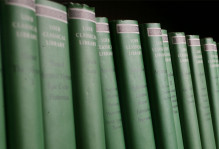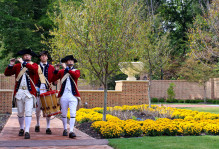Class site visits
In addition to our biweekly classes that meet on Tuesdays and Thursdays after our internship, otherwise known as our “9 to 5’s,” we also have site visits on Friday. “Site visit” is really just a glorified way of saying field trip — at least that’s how I see it, and it’s fine by me — anything that keeps me feeling young is cool.
So far we’ve visited the Gelman Library at George Washington University, Library of Congress and its Packard campus for Audio Visual Conservation, C-SPAN, National Archives, and Pulitzer Center for Crisis Reporting. This coming Friday, which is Family Weekend, we’ll be having our site visit at the Newseum. During these site visits, we go on a tour of the institution with an employee while engaging in active discussion. From these talks, we learn a lot of valuable information that not only concerns the organization at hand but also issues that impact them.
Because we’re studying new media and culture, there has been a steady stream of keywords that continue to pop up during our visits and our class readings. We’ve come across issues such as digitization, intellectual property, copyright and fair use, the switch to HD, upgrades in technology, the integration of social media, and the use of new media to provide more access to consumers. Sometimes we pack the day with two site visits which doesn’t sound like a big deal, but surprisingly drains most of our energy!
We have been extremely fortunate enough to spend time with professionals that are passionate about what they do. Here are the names of the people we’ve spoken to–through the art of networking, we’ve come across some alums. Speaking of alumni, we also had our Annual W&M Reception alumni event at the Embassy of Australia just last week for the greater metropolitan/Northern Virginia area. It was pretty sweet listening to President Reveley discuss why the griffin wears no pants (it’s not gender specific). This was of course during candid conversation. Reveley, more importantly, addressed how W&M is going through tough financial times, with 88% of our funding coming from private sources. He talked about how our College can no longer depend on the state of Virginia to help us out, etc.
Back to the subject at hand. Here were the professionals we spoke to and some of their key points they made:
Gelman Library, GW:
- Ann Brown, Reference and Instruction Librarian: Brown discussed GW’s project on digitizing media (VHS, DVD) and making them accessible on Blackboard for students. She said their streaming services was a major hit at GW, with the library receiving 12,000 hits in one semester versus 1,500 circulation items over the course of a year. Some of the challenges their staff faced while streaming media included intellectual property rights, breaking encryption, and experiencing copyright issues.
Library of Congress:
- Abby Yochelson, Reference Specialist: Yochelson informed us that the LOC has recently amassed all of Twitter’s tweets for archiving purposes so that future generations can look back at what we are tweeting today! Worth it? Only time will tell. Although, speaking from my internship experience, I know that the world of television and DC politicians love Twitter. It’s the new bathroom wall, Pete Williams, NBC Chief Justice Correspondent told us interns over lunch today.
- Patrick Loughney, Director of the Packard Campus: Patrick engaged us in an active discussion on whether film is considered art. Is the medium itself art? Or is it only what is recorded on to the medium that can be so? What items are preserved and what constitutes the canon in media archiving? He also showed us sub-zero chambers where historic media pieces were stored, including Dorothea Lange’s “Migrant Mother.”
C-SPAN:
- Brian Lamb, Founder and CEO of C-SPAN: Lamb discussed how C-SPAN maintains a lot of independence because it is not for profit. Not fueled by money, the public service channel is free to work on projects they think are relevant. Lamb talked about the power of change and choice that has come with new media, stating that during his youth, there were only 3 channels — Now viewers have the choice to watch what they want. It has changed the relationship and perception viewers have of news media.
- Mark Farkas ’83, Executive Producer of historic programming documentaries covering the White House, Capitol, and Supreme Court: Farkas stated that the news paradigm has changed much since the internet, and that with these new media changes, producers must react accordingly. C-SPAN manages change by leveraging the multi-platform of tv, radio, web to reach out to viewers in more ways.
The National Archives:
- John Powers ’89, Civil Work Group II Leader– Classification Management of the Information Security Oversight Office (ISOO): Powers described that an archivist works with agencies to determine which records are permanent or temporary. They are responsible for archival processing and reviewing records for restriction. He stated that the National Archives is first and foremost an institution that protects the rights of citizens by archiving documents of national interest. There are currently 10 billion pages of paperwork that are classified to be permanent records of the government. Yet this only makes up 3 to 5% of the archive collections!
Pulitzer Center for Crisis Reporting:
- Ann Peters, Director of Development and Outreach
- Summer Marion ’08, Special Projects Coordinator
- Peters and Marion, together, approached topics on journalistic ethics and standards. They explained that their news organization operates differently from other news outlets because it funds international projects that are under covered in main stream media. Some of their news projects include the water crisis and Lord’s Resistance Army. Marion stated that Pulitzer Center strives to transform journalism from information to engagement. She mentioned that the reality of main street news was that “covering Britney is cheaper.” In regards to conforming to main stream media, Peters commented that “regardless of how the media landscape changes, we have to focus on what our ethics and standards are.”




No comments.
Comments are currently closed. Comments are closed on all posts older than one year, and for those in our archive.